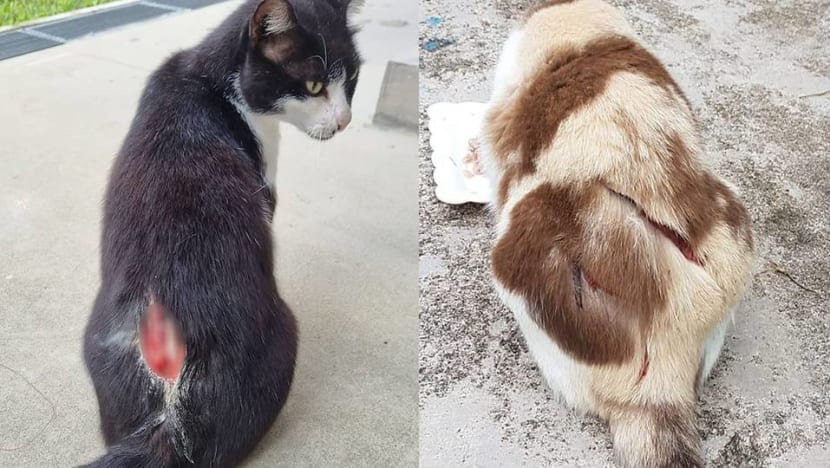commentary Commentary
Commentary: Do we need to do more to protect our community cats?
Animal cruelty has no place in our society and nobody should want to see a sentient being experience unnecessary pain or suffering, says SPCA’s Executive Director.

Boy Boy (left) and one of the cats from the mother and daughter pair. (Photos: Ang Mo Kio South Caregivers and Feeders)
SINGAPORE: There has been a recent spate of violence against community cats in Ang Mo Kio with at least 10 cats found with deep linear slash-type wounds on their bodies. Many in the community are deeply troubled and have voiced their concerns, wanting to see quick action taken to find the suspect.
This is unfortunately not the first time Singapore has seen serial cruelty enacted against cats. Some of the past perpetrators have been prosecuted, while other cases involving multiple injured cats remain unsolved.
COMMUNITY CATS ARE PART OF OUR ENVIRONMENT
These cats are in our communities through no fault of their own. Many have been abandoned or are descendants of abandoned cats.
READ: Commentary: Are we inept at handling wild animals that come our way?
There are extensive efforts by numerous organisations and countless individuals to humanely manage and reduce the cat population in Singapore. This is done via surgical sterilisation of the cats so they can no longer reproduce and the provision of dedicated care for the animals while they live out their lives.
The act of feeding sterilised cats does not increase the cat population. It is thus unfair to blame feeders for the presence of the cats. Many a time, when someone complains, there are also efforts to understand their frustrations through mediation so that a compromise can be reached.
We know of many feeders who have moved their feeding sites or adjusted their feeding schedules so as to minimise any potential nuisance.
READ: Commentary: We never give up trying, but not every rescue dog will find a home
Cats are part of our built-up environment and live comfortably alongside humans. Many dedicated caregivers contribute immensely to their care.
We have heard many stories of neighbours coming together to care for the cats, developing lifelong friendships and connections in the process.
Affinity or not, we have to learn to co-exist with the animals around us.
WE CAN’T ACCEPT ANIMAL CRUELTY
Animal cruelty has no place in our society and nobody should want to see a sentient being experience unnecessary pain or suffering.
Of course, even if one thinks that an animal is a nuisance, there is just no excuse for violence. Just as there would be no excuse to commit a crime against a person because they have bothered another.

This reason alone should be sufficient to cause us great concern and spur fast and strong action in animal cruelty cases. Thankfully we see many people speaking up when a case makes the news, giving us hope that we have a significant part of our society that rejects animal abuse.
If we needed another reason to be concerned, it is that studies have long found a link between animal cruelty and violence towards humans. Leaving animal abuse unpunished and otherwise not dealt with, be it in a treatment or correctional facility, may place the people in a society in danger too.
READ: Commentary: To reduce wildlife attacking humans, stop feeding them
The injuries found on the cats in Ang Mo Kio reflect a determined, intentional, and committed pattern to inflict suffering on the animals. The intentional and cruel nature of the abuse and the hunting of multiple cats to commit the violence is disconcerting.
This should thus concern all of us.
TRYING TO UNDERSTAND ABUSE
There could be a number of reasons why people commit cruelty to an innocent being, though we have to accept that we might never fully understand the motivations.
In some of these cases, human mental illness may play a part. In 2006 and 2007, a serial cat abuser in Bedok who had tortured multiple cats by strangling them was reported to have been diagnosed with anti-social personality disorder. In 2016, a man suffocated and then stabbed his pet dog to death. He was diagnosed with adjustment disorder with depressed mood and given a 12-month mandatory treatment order.

In other cases, the person may enjoy control over another being or be taking out their frustrations on an animal that cannot retaliate. Individuals may also displace their aggression from a human to an animal, or use cruelty as a means to threaten someone.
In 2020, a man was charged with animal cruelty for killing a kitten during an argument with his wife. He flung the animal against a cupboard and then picked it up and told his wife, “Look at this because of you”. He then flung the animal on the floor and said to his wife, “If I can do this (to the cat), you I don’t care”. He later threw the kitten down the rubbish chute.
READ: Commentary: The problem with sharing cute exotic animal pics
READ: Commentary: The wonder of clear skies and returning wildlife is our new climate problem
On social media, we also see cases where people post videos that they think are entertaining, seemingly trying to attract attention and obtain “likes” and “shares”. Last year, a series of videos went viral in which youth were seen abusing frogs.
Profit has also driven some to commit horrendous acts of cruelty. “Crush” videos where people are seen literally crushing animals to death surface every now and then. These videos, associated with sexual fetishes, are produced overseas for an underground international market.
When it comes to community cats, it is also possible that abuse stems from a dislike or hatred of having these animals around.
It is not uncommon for us to hear of cases where community cat caregivers have been verbally abused by individuals who have asked them to stop feeding the cats. In some of these cases, the individuals have threatened to hurt the cats if the feeding doesn’t stop.
WE NEED TO DO BETTER
Regardless of the reason for the abuse, animals rely on us to be their voices and advocates and this places a heavy responsibility on our shoulders.
Cruelty cases need to be solved faster so that more animals are not harmed. In the 2006 and 2007 Bedok case mentioned above, the community mobilised in a big way and it was through their efforts of patrols and constant monitoring that the case was solved and the perpetrator brought to justice.

Today, with a wide CCTV network and other tools available to enforcement agencies, such cases should be solved much more quickly, similar to how fast many other cases involving crimes against humans are solved.
If this means we need to put more resources towards animal cruelty investigations, such as more manpower or the use of technology and forensics, then this should be done.
The cats in Ang Mo Kio and the other animals in our midst deserve better.
Dr Jaipal Singh Gill is Executive Director of SPCA in Singapore.














